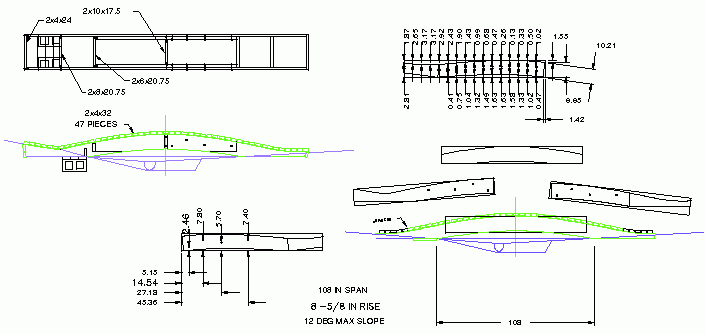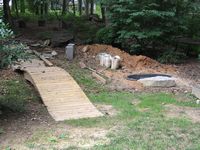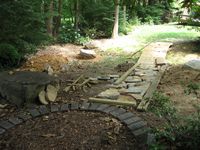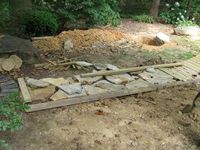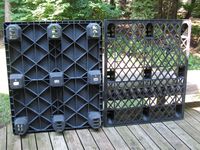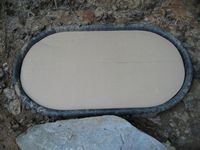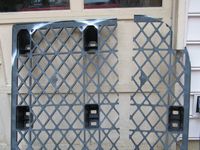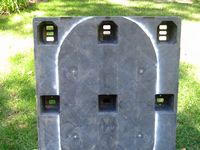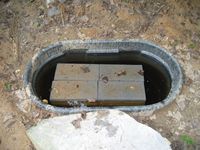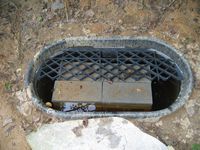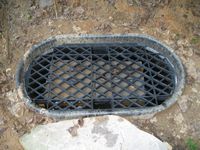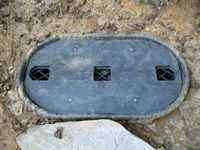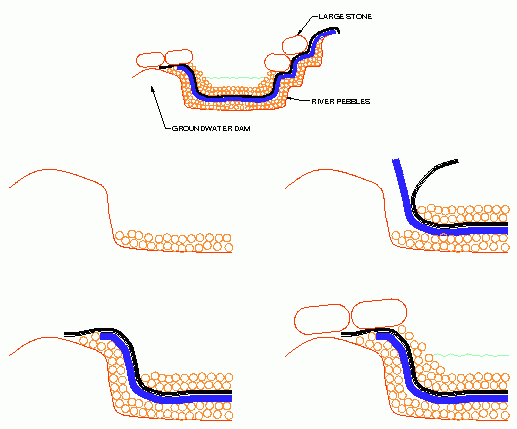Month six has drug out way beyond what was expected so I have broken it into five sub sections.
First Try
Now that the basic elements were in place, it was time to start building the actual stream.
I had all winter to visualize what path the stream would take, so as soon as weather permitted, I began digging an oversized ditch. The ditch was about 6-inches deep to accomodate the average 2-deep stream. Why so deep? Underneath the liner is a layer of sand, a layer of old carpet, and a 2-inch layer of 3/4-inch river stone. The stone is a mole barrier, the carpet is a root barrier, and the sand is a surface smoothing medium.
In my mind this seemed like a formitable task. In actuallity it was worse than I imagined. Estimating how deep to dig to allow for the gravel and underlayment carpet was difficult. Visualizing where rocks would go and what their effect would be, then planning for keeping ground water out of the stream, made this more of a hope-and-pray exercise than a build-to-drawing operation. The first test was encouraging, unless you think water coming from under my plastic-sheet test liner wasn't planned. Sealing the spillway boulder to keep water from following the boulder wall underneith the boulder and then underneath the liner was not a task I comfortably felt would be a permanent fix. Sore by the end of the day, I was wondering how much it would cost to rent a bulldozer to level the whole thing.
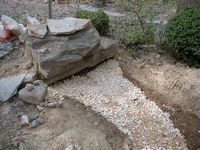
2" gravel mole guard.
|
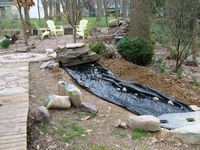
Plastic sheeting flow test.
|
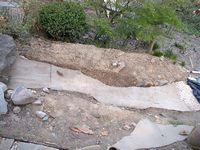
Carpet underlayment over gravel.
|
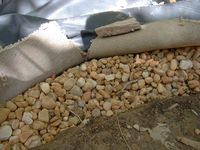
Mounds formed under sides.
|
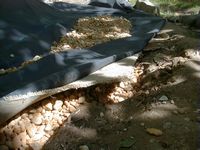
Gravel in center of liner.
|
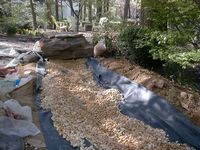
Liner tucked over mounds.
|
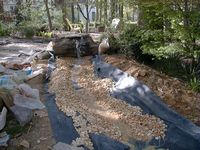
Water test.
|
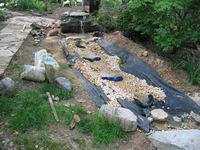
Sandbag falls.
|
Waterfall Leak
Now, before I could start adjusting the water flow to get a gurgling stream, I needed to make the water come off of the big rock correctly. The curve of the rock caused the water to flow back under the rock and under the liner. As I saw it, the only solution was to glue on a deflector strip of liner to catch the mis-directed water and redirect it into the stream. Since I would be attaching liner to the rock, I decided to attach another piece to the side of the rock so I could allow some water to flow gently over the side for astetics. This would increase the evaporation, but I thought it looked nice.
I looked at epoxy, polysulfide, polyether, and polyurethane adhesives to bond the liner to the rock. All the adhesives would stick the liner in place (I thought), but only a marine polyurethane from 3M was rated for water immersion. The others are waterproof, but not rated for immersion. I use PL Premium polyurethane for many projects and it is great stuff at a good price, but it clearly states that it is not intended for water immersion. Some of the other brands are not so forthcoming in declaring their lack of immersion survival.
Clamping the glued liner to the wire brushed, water scrubbed rock was a challenge (modern euphonism for what I always called a problem). I decided to use sand bags. It doesn't take a lot of force as the liner is not stretched, but the shape is irregular and the sandbags conform to the rocks shape. After a dry run, I found the sand bags were not enough. The rubber liner wanted to pull away from the rock at the very edge of the liner. This I solved by using every man's favorite tool, duck tape. It stuck to the rock and the rubber long enough for the adhesive to cure, and was strong enough to hold the edge of the liner flush with the rock.
I made a discovery while waiting the 7 days for the adhesive to cure; 3M5200 doesn't stick well to EPDM rubber. This illustrates the danger of Internet research, you get a lot of mis-information. The bond strength of 3M5200 to EPDM is 10 psi compared to 44 for vinyl, 101 for steel, and 243 for fiberglass. Since the added piece of EPDM is a flap to get the water redirected into the stream, and not part if the stream liner, the solution might have been to use a different rubber, maybe neoprene or nitrile, instead of EPDM for the flap. But, as with the EPDM there is no information available on how well the 3M5200 sticks to the other rubbers. If, or when , the current flap starts to tear away I may replace it with another rubber type, or I may try putting many perforations at the edge of the flap so the 3M5200 can form a mechanical bond to bolster the chemical bond. Another possibility would be to replace it with a fabric-backed, or fiberglass-backed, vinyl-faced material; the adhesive would stick to the fabric and the vinyl would repell the water. Yet another possibility has presented itself. I have found a silyl terminated polyether hybrid adhesive, Chem Link M-1, that is immersible and specifically lists EPDM and stone as two of the substrates it bonds to. Due to my mistrust of Internet research, I will have to check it out further.
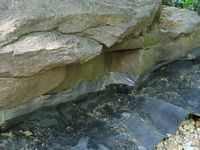
Liner glued and taped to rock.
|
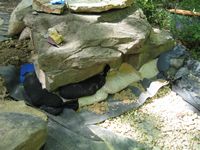
Glued, taped, and sandbagged.
|
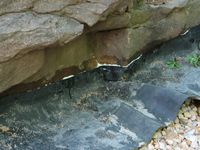
Cured liner flap.
|
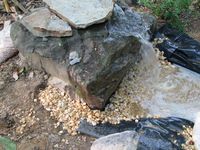
Camoflaged and covered .
|
Pump Problems and Water Loss
After a weekend in New York, I returned to find a dead pump. The motor was running but it was not pumping water. The impeller had wobbled off the shaft, but even after it was replaced, the pump had low pressure and went into thermal shutdown after a very short time.
So what killed it? Was it that the water level had dropped below the pump inlet because the pump was not on the bottom of the tank. Yes. Was the water loss excessive, which dropped the level in the tank to less than one half? Yes. Shouldn't there have been protection designed into the plumbing? Yes. Shouldn't the pump been able to survive the water loss? I'd like it, but none are able to in this flow class.
Solution: buy new pump, lower pump, correct water loss, add automatic water fill, add low-water pump shutdown.
Lowering the new pump was easy. By substituting a modified 12-inch block for one 8-inch block and one 4-inch block in the pallet support pedestal, I made space on the bottom of the tank for the pump. Using a carbide tipped drill bit , I cut the side and center out of the 12-inch block to give me a U-shapped block that goes over the pump. Re-plumbing the pipe to get the pump connected to the backflow valve at exactly the same point where it was previously connected turned out to be easy, as the pump output port was nearly lined up after the move. I didn't put the cost of this change into the cost breakdown because if I had done it right the first time it would have been zero cost.
I found a sump pump piggyback float switch on E-Bay for $27.50 including shipping. This provided me a quick means of protection to stop pump damage when the water drops too low. If I ever get this project finished enough to consider putting in an automatic filling system, I will look at integrating the low-water-shutdown and automatic-fill functions into a
single water level sensor assembly.
The water loss is still being investigated. There is a tremendous amount of splash at the water fall, and this could be the source. I don't think any water is leaking behind the skirt on the rock, but I will recheck that area. It looks like I will be removing some gravel and doing some repositioning of the liner.
Second Try
In the first trial I used the sand filled socks (sandbags) from the flap glueing to act as temporary rocks. This let me make easy changes to the stream bed and see how the water would move before I wrestled a heavy rock in place. What I discovered was the drainage channels didn't work, I didn't have enough terracing behind my rapids, and I lost too much water from waterfall splash.
All the stream rock was removed, and I started over.
To keep out groundwater run-off from the dirt mound next to the stream, a drainage channel was to be dug beside the stream. The drainage channel would be about 6-inches wide and 6-inches deep and be filled with river gravel. This was a impractical plan. Just a lot of work preparing the shape of the bottom surface and a lot of work trying to get the carpet to make sharp compound curves. After trying this and having to dig it out, I can say positively it is just better to dig the trench with vertical walls and use the gravel to smooth the edges. Lay the carpet up the sides as high as the waterline then bring the liner over the edge of the carpet.
The steps were kind of like this:
(1) put in the mole guard layer,
(2) put in the carpet and the liner and put gravel over them in the center of the stream,
(3) lift up the edges of the carpet and liner and stuff gravel between the vertical trench walls and the carpet,
(4) lay the carpet and liner over the added gravel to form the sides,
(5) tuck the ends of the liner down over the carpet and cover with more gravel.
The water in the stream moved way too fast and pushed my river pebbles down stream. I fixed this by increasing the terracing of the bed behind my rapids falls until they were level. and in some cases reverse sloping. This created a small puddle behind the rapids fall and slowed the water movement.
Splash from the waterfall sent drops 3- to 4-feet beyond the falls. I couldn't tame the falls, so I had to make the liner catch the water and return it. I didn't want the stream to be wider at that point, so I layed the liner above the waterline out as far as the falls water splashed and covered it with gravel and rocks. The water that splashes out drips through the gravel and eventually drains down into the stream.
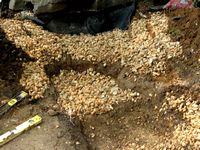
Re-dig for terraces.
|
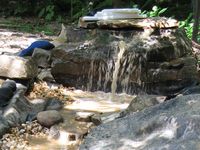
Anti-splash pool.
|
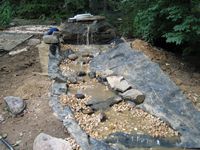
Slower flow.
|
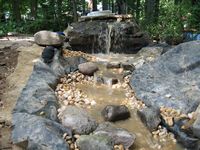
Muddy water falls.
|
Rock Arrangement
The final stage looks like a never ending saga - arranging the rocks and gravel. Several large rocks were found on the many drives sightseeng through Pennsylvania, and these form the major chunks of the stream. Other rocks are being added to get the desired flow. As I did before, I am using the sand filled socks (sandbags) from the flap glueing to act as temporary rocks and see how the water will move. A sandbag under a rock, or rocks, can also give the rocks a solid base to hold them in place, distribute their load over a larger area to protect the liner, and form a seal between the rocks and liner to keep water from leaking under the rocks.
Near the edge of the stream I couldn't bring the gravel up to the dirt without the black liner showing through. My solution was to use a cement stabilized soil over the liner there. The stabilized soil holds its position, doesn't dissolve easily in the stream water, and looks like a dirt stream bank. The stabilized soil is made by mixing (by volume) 1 part type-N masonary cement to 3 parts dirt. It is better to use dirt with a minimum of vegatative matter in it, but is not critical. I mixed in just enough water to make the thick mud spreadable over the liner, then patted some un-stabilized garden soil on top of the mud to make it look more realistic.
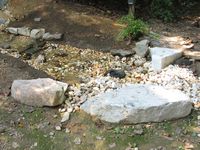
Stabilized dirt bank.
|
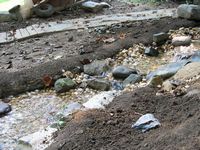
Other side bank.
|
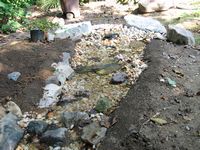
Bottom half done.
|
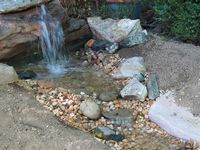
Top half at falls.
|
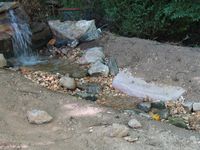
Top half done.
|
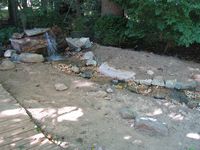
Rock placement done..
|
Before and After
Pictures for comparison to the baseline pictures of the area before any digging started.
